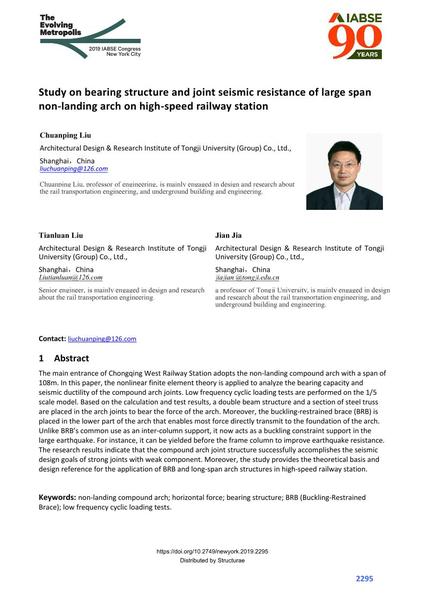Study on bearing structure and joint seismic resistance of large span non-landing arch on high-speed railway station

|
|
|||||||||||
Bibliographic Details
| Author(s): |
Liu Chuanping
(Architectural Design & Research Institute of Tongji University (Group) Co., Ltd.)
Tianluan Liu (Architectural Design & Research Institute of Tongji University (Group) Co., Ltd.) Jian Jia (Architectural Design & Research Institute of Tongji University (Group) Co., Ltd.) |
||||
|---|---|---|---|---|---|
| Medium: | conference paper | ||||
| Language(s): | English | ||||
| Conference: | IABSE Congress: The Evolving Metropolis, New York, NY, USA, 4-6 September 2019 | ||||
| Published in: | The Evolving Metropolis | ||||
|
|||||
| Page(s): | 2295-2301 | ||||
| Total no. of pages: | 7 | ||||
| DOI: | 10.2749/newyork.2019.2295 | ||||
| Abstract: |
The main entrance of Chongqing West Railway Station adopts the non-landing compound arch with a span of 108m. In this paper, the nonlinear finite element theory is applied to analyze the bearing capacity and seismic ductility of the compound arch joints. Low frequency cyclic loading tests are performed on the 1/5 scale model. Based on the calculation and test results, a double beam structure and a section of steel truss are placed in the arch joints to bear the force of the arch. Moreover, the buckling-restrained brace (BRB) is placed in the lower part of the arch that enables most force directly transmit to the foundation of the arch. Unlike BRB’s common use as an inter-column support, it now acts as a buckling constraint support in the large earthquake. For instance, it can be yielded before the frame column to improve earthquake resistance. The research results indicate that the compound arch joint structure successfully accomplishes the seismic design goals of strong joints with weak component. Moreover, the study provides the theoretical basis and design reference for the application of BRB and long-span arch structures in high-speed railway station. |
||||
| Keywords: |
non-landing compound arch horizontal force bearing structure BRB (Buckling-Restrained Brace) low frequency cyclic loading tests
|
||||
